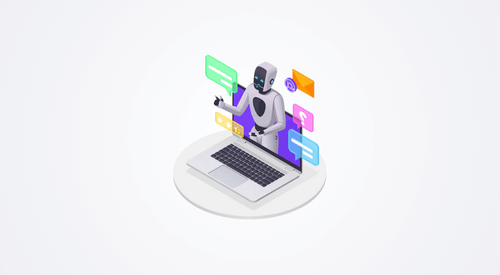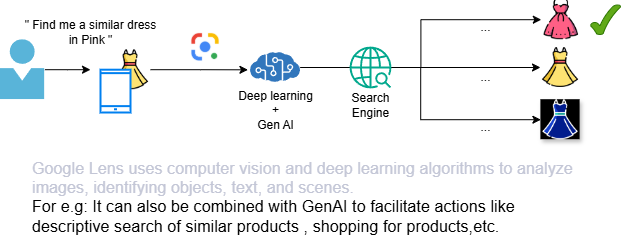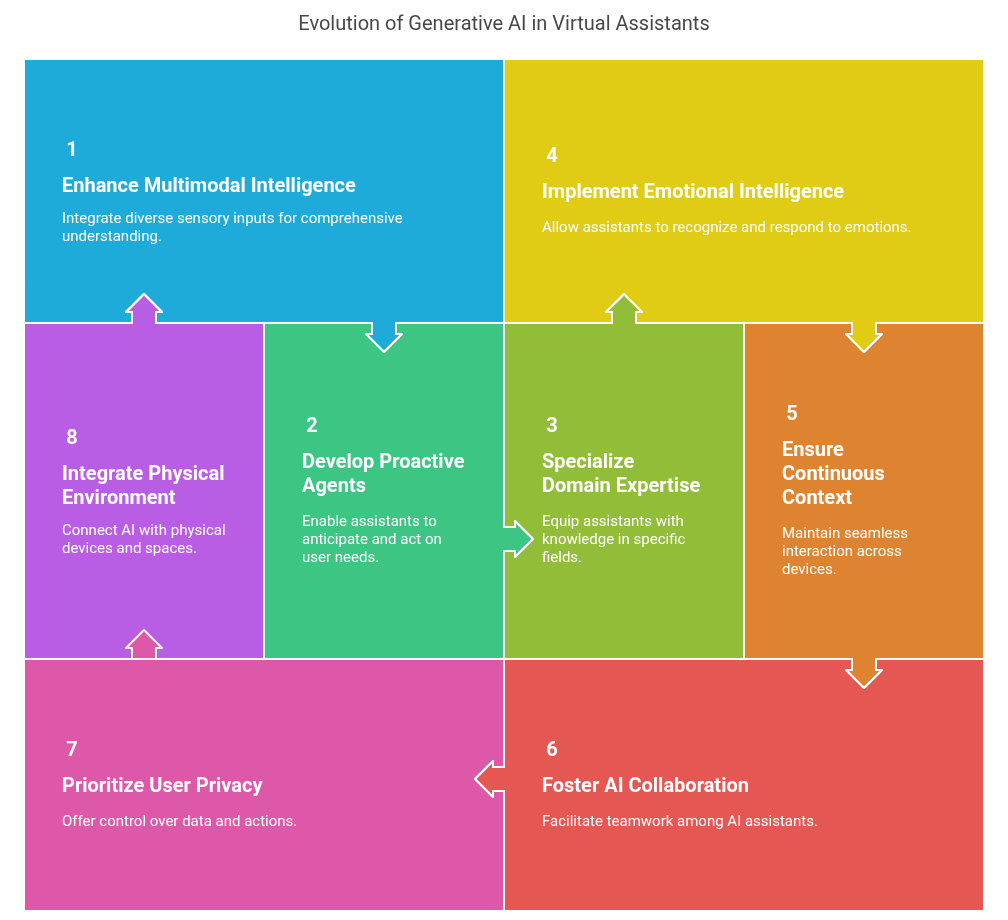

The global AI-powered virtual assistant market is projected to expand from USD 10.4 billion in 2024 to USD 154.8 billion by 2034, reflecting a compound annual growth rate (CAGR) of 31.00%. Virtual assistants have come a long way from the days of rigid, rule-based bots that could only follow pre-set scripts. Thanks to generative AI, especially large language models (LLMs) like OpenAI’s GPT-4 and Google’s Gemini, today’s virtual assistants have become more intelligent, adaptable, and skilled at engaging in fluid, human-like discussions. In this blog, we explore how Generative AI in virtual assistants is driving a transformative shift in user interactions and intelligent automation.
Discover how Generative AI is reshaping interactions
AI-powered virtual assistants comprehend context, handle intricate inquiries, and are capable of producing imaginative content. This evolution signifies the emergence of AI companions that extend beyond mere question-and-answer interactions to genuinely support tasks, decision-making, and everyday activities.
From Rule-Based Chatbots to Conversational AI
Traditional chatbots operated much like decision trees, relying on specific keywords or menu options. This approach worked well when the inquiries were aligned with the script, but fell short when a user expressed something differently or posed an unexpected question. For instance, a banking bot might only respond if you type “Check balance,” whereas a Generative AI assistant could comprehend “How much money do I have left?” and deliver the appropriate reply. Generative AI bots utilize LLMs and NLP to grasp context rather than merely focusing on particular words, which enhances their adaptability.
However, this adaptability isn’t always advantageous. In structured scenarios, such as booking a hotel room, rule-based chatbots tend to outperform because they adhere to a fixed process, consistently requesting check-in dates, room selections, and payment information in a logical sequence. On the other hand, Generative AI might find it challenging to maintain structure if a user diverges significantly from the topic.
Nevertheless, with recent improvements in platforms like Dialogflow, it is now feasible to create chatbots that harmonize structure with the freedom of natural language, enabling users to communicate casually while still adhering to a defined process.
If Generative AI chatbots can effectively maintain structured interactions, they may eventually supersede traditional bots entirely, providing an optimal blend of both approaches. Additionally, these AI-driven assistants can be designed with unique personalities, resulting in more humanlike interactions that feel engaging and personalized, transforming the experience from interacting with a rigid machine to one that is much more relatable.

Image 1: Comparison of Structured vs. Unstructured Chatbots
How Generative AI in Virtual Assistants Enables Natural Interactions
Generative AI in virtual assistants is driving transformation, making interactions feel more seamless and natural. Unlike conventional chatbots that rely on strict scripts, these AI systems comprehend and produce language similarly to humans, maintaining context through conversations. With memory capabilities, they tailor responses by recalling user preferences, making recommendations like “How about a vegetarian pizza tonight?” based on previous exchanges.
In addition to conversation, AI assistants are now capable of automating tasks with greater flexibility. Google Assistant used to require specific phrases for functions like setting alarms, scheduling appointments, or making calls; however, with Gemini, users can communicate naturally. AI can perform more intricate automation tasks, such as summarizing emails or writing messages in various tones.
Modes of Interaction: Beyond Text and Voice
Today’s Generative AI in virtual assistants is no longer confined to just chat windows or voice commands. Modern assistants engage users across multimodal interfaces, text, voice, images, and even video, enabling more immersive and intuitive interactions. For instance, you could ask a virtual assistant to “find me a dress like this” while uploading a photo, and it would scan fashion catalogues using visual search capabilities to match styles.
This multimodal intelligence is fueled by advanced LLMs that understand language, visual, audio, and even spatial data, making them context-aware in a broader sense. Imagine giving verbal instructions to a smart display while pointing at something on-screen. Soon, AI assistants will be interpreting both the gesture and the spoken command together.
Moreover, these assistants are becoming ubiquitous across devices: phones, smartwatches, TVs, cars, and even AR glasses. This seamless presence ensures continuity in interaction: You would be able to ask your phone assistant to remind you to pick up groceries, and your car’s assistant might later alert you when you drive past a store.

Image 2: Multimodal AI for Smart Search and Assistance
Agentic Systems: Toward Autonomous Goal Fulfillment
What truly sets the next-gen virtual assistants apart is their shift from reactive tools to proactive agents capable of understanding high-level goals, autonomously planning steps, and executing actions across applications and services.
These agentic systems are powered by an orchestration of Generative AI, memory modules, tool-use capabilities, and environment awareness. They don’t just respond; they act. For example:
-
- A user could say, “Help me plan a weekend getaway under $500.”
- The agent breaks this into sub-tasks: search travel deals, compare hotels, check calendar availability, and even notify friends.
- It leverages APIs, booking platforms, calendars, and maps all without the need for micromanagement from the user.
We’re looking at a near future where AI agents may evolve into co-pilots for life, capable of managing schedules, summarizing information, negotiating deals, and even making ethical trade-offs in decision-making under your defined boundaries.
Image 3: Agentic Virtual Assistant: Automated Travel Planning Workflow
Real-World Use Cases Across Industries
Generative AI-powered assistants are transforming industries with their versatility and scale:
-
- Customer service: Dialpad’s AI Contact Center showcases how Generative AI enhances virtual assistance in customer service. It offers real-time transcription and sentiment analysis, enabling agents to adjust their responses promptly. The platform provides AI-driven assistance by automatically displaying helpful information during calls, streamlining interactions, and boosting productivity. Additionally, Dialpad automates quality assurance through AI Scorecards, which assess agent performance and highlight coaching opportunities. Intelligent call routing ensures customers are efficiently connected to the appropriate resources. Collectively, these features demonstrate the potential of Generative AI to transform virtual assistance by improving support, automating tasks, and delivering actionable insights for more effective customer service operations.
- Healthcare: Woebot is an AI-powered chatbot designed to provide mental health support by engaging users in therapeutic conversations grounded in cognitive behavioral therapy (CBT) principles. Accessible via smartphones or tablets, Woebot offers real-time, 24/7 assistance, allowing users to monitor and manage their moods through tools like mood tracking, progress reflection, gratitude journaling, and mindfulness practices.
- Enterprise productivity: AI personal assistants help individuals manage tasks like email organization, scheduling, and reminders, effectively functioning as digital concierges.
- Coding: Tools like GitHub’s Co-pilot act as AI pair programmers, providing real-time code suggestions and entire function completions based on the developer’s context. This accelerates the development process, reduces manual coding effort, and allows developers to focus on higher-level problem-solving. GitHub Co-pilot enhances productivity and streamlines workflows by integrating seamlessly into code editors.
- Personal use: AI personal assistants like Lindy are becoming integral in managing daily tasks such as email organization, scheduling, and reminders. For instance, AI scheduling assistants can automate meeting arrangements, set reminders, and manage calendars, learning user preferences over time to optimize scheduling. These assistants help individuals stay organized and efficient, effectively functioning as digital concierges.
What’s Next for Generative AI in Virtual Assistants
As Generative AI in virtual assistants rapidly progresses, the future landscape of virtual assistants is set to become more intertwined, intelligent, and human-like than ever before. Here’s a look at what lies ahead:
-
- Holistic Multimodal Intelligence: Virtual assistants will evolve beyond isolated channels, gaining the ability to comprehend and react to voice, text, images, videos, and gestures simultaneously. You might present your assistant with a broken item, ask, “Can you help fix this?” and receive both a visual diagnosis along repair guidance or service appointment options.
- Proactive & Independent Agents: Assistants will take initiative rather than merely waiting for commands; they will foresee needs based on user habits, context, and external information. From rescheduling appointments following a flight disruption to proposing budget adjustments before a payment is due, agentic AI will act proactively while ensuring users remain informed and in control.
- In-Depth Domain Expertise: Future assistants will not only engage in conversation; they will have specialized knowledge in various fields. Anticipate AI copilots that excel in healthcare, law, finance, and education, combining natural dialogue with expert-level insights to support decision-making responsibly and accurately.
- Emotionally Intelligent Interactions: Thanks to advancements in sentiment analysis and affective computing, assistants will start to recognize feelings based on vocal tone, word selection, and facial expressions. Whether it’s showing empathy during difficult times or celebrating achievements, upcoming AI will react with enhanced emotional awareness.
- Continuous Context Across Devices: Your assistant will keep track of your activities from your smartphone and computer to your vehicle and smart home, maintaining context across different platforms. You could initiate a discussion on your smartwatch while running and seamlessly continue it on your home speaker without losing continuity.
- Collaboration Between AIs: In the foreseeable future, virtual assistants will work in tandem. Imagine your assistant collaborating with a colleague’s AI to automatically find mutual meeting times, delegate tasks, or share project updates.
- Privacy and Control Focused on the User: As AI becomes increasingly personal, building trust will be essential. Anticipate detailed control over data access, assistant behavior, and limitations, such as disabling specific actions (“never share my information” or “ask before making purchases”).
- Integration with the Physical Environment: AI will expand beyond screens. When integrated with smart homes, wearables, and even robotics, assistants will engage with the surrounding environment, adjusting lighting, operating appliances, guiding drones, or managing machinery through voice or gesture commands.

Future of Generative AI in Virtual Assistants
Conclusion
Generative AI has redefined what virtual assistants can be-shifting from rigid, rule-based bots to intelligent companions that understand, adapt, and act. No longer limited to basic Q&A, today’s assistants can plan trips, automate workflows, manage calendars, and offer meaningful support across personal and professional domains. This transformation is driven by advances in language understanding, memory, emotional intelligence, and agentic behaviour. Virtual assistants are quickly evolving to be proactive collaborators capable of anticipating needs, handling complex tasks, and offering personalized guidance with minimal input.
As these systems continue to evolve, they’ll move seamlessly across devices, interpret emotions, and interact with the physical world, blurring the lines between digital and real-life assistance. We’re entering an era where AI isn’t just smart, it’s helpful, human-like, and truly personal.
At Niveus Solutions, we are at the forefront of the AI revolution, leveraging Generative AI to build intelligent, scalable, and transformative virtual assistants tailored to business needs. Whether it’s enhancing customer engagement, optimizing enterprise workflows, or driving automation, we help organizations harness the full potential of AI-powered assistants..
Discover how AI is revolutionizing virtual assistance












